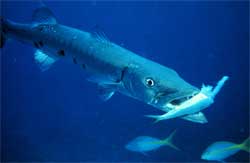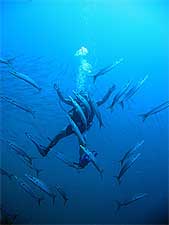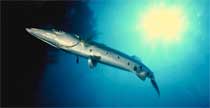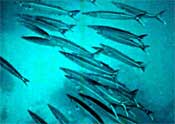|

 Barracudas are elongated fishes with powerful jaws. The lower jaw of the mouth juts out beyond the upper jaw. Barracudas possess strong, fang-like teeth. Their heads are quite large and pointy. Barracudas are elongated fishes with powerful jaws. The lower jaw of the mouth juts out beyond the upper jaw. Barracudas possess strong, fang-like teeth. Their heads are quite large and pointy.
In general, the barracuda's coloration is dark green or grey above chalky-white below. Sometimes there is a row of darker cross-bars or black spots on each side. The fins may be yellowish or dusky.

 The Element of Surprise: Barracudas travel independantly as well as in schools, and dwell near reefs or open seas. They are voracious predators and hunt using a classic example of lie-in-wait or ambush. They rely on surprise and short bursts of speed to overrun their prey. The Element of Surprise: Barracudas travel independantly as well as in schools, and dwell near reefs or open seas. They are voracious predators and hunt using a classic example of lie-in-wait or ambush. They rely on surprise and short bursts of speed to overrun their prey.
Big and Greedy: The larger barracuda are more or less solitary in their habits. Young and half-grown fish frequently congregate in shoals. Their food is composed almost totally of fishes of all kinds. Large barracudas, when full, exhibit the curious tendency to hoard a shoal of fishes in shallow water, guarding over them until they are ready for another meal.
Gentle Giants: Like sharks, barracudas have long suffered from an unjust bad reputation inflicted on them by the media. In reality, unprovoked attacks on humans are extremely rare and millions of scuba divers, snorkelers and swimmers spend time with them in the water without any incidents. Barracudas sometimes do follow snorkelers and scuba divers across the reef, which can make one feel uncomfortable, but still they are completely harmless unless provoked. Handfeeding or trying to touch them is strongly discouraged. Spearfishing around barracudas can also be quite dangerous, as they are strongly attracted by the wounded fish.
 Nobody's Perfect: There have been isolated cases where barracudas did bite a Nobody's Perfect: There have been isolated cases where barracudas did bite a
human thinking that part of it was a fish, but these incidents are extremely rare and
are generally caused by bad visibility. Barracudas will always stop after the
first bite as humans are not their normal
food source.

 Barracudas belong to the great order of Perch-like fishes, Percomorphi. Along with the smaller grey mullets and sand smelts or atherines, barracudas form the suborder known as mugiloids. Barracudas belong to the great order of Perch-like fishes, Percomorphi. Along with the smaller grey mullets and sand smelts or atherines, barracudas form the suborder known as mugiloids.
Members of this group are distinguished from the Percoids by the backward position of the pelvic fins, which are located well behind the pectorals.
Only some species of barracuda grow to a large size. The species which do are the European barracuda, barracouta or spet (S. sphyraena), found in the Mediterranean and eastern Atlantic; the great barracuda, picuda or becuna (S. picuda), ranging on the Atlantic coast of tropical America from Florida to Brazil and reaching the Bermudas; the California Barracuda (S. argentea), extending from Puget Sound southwards to Cape San Lucas; the Indian barracuda (S. jello) and the black-finned or Commerson's barracuda (S. commersoni), both from the seas of India and the Malay Peninsula and Archipelago.
All text is available under the terms
of the GNU Free Documentation License
|